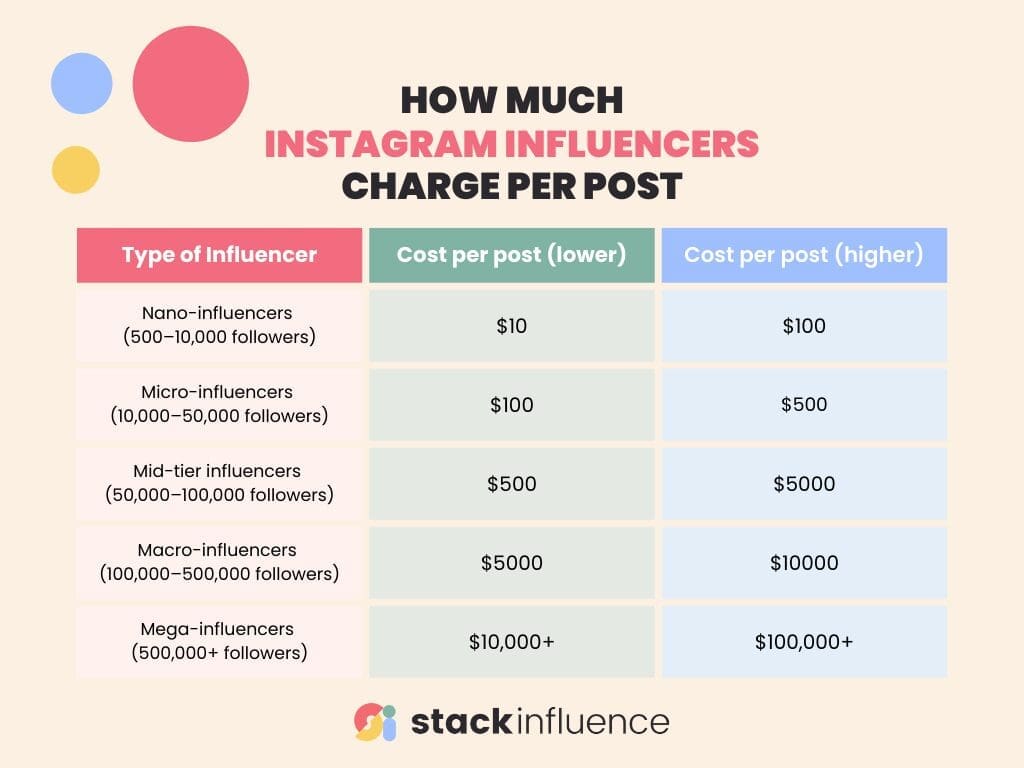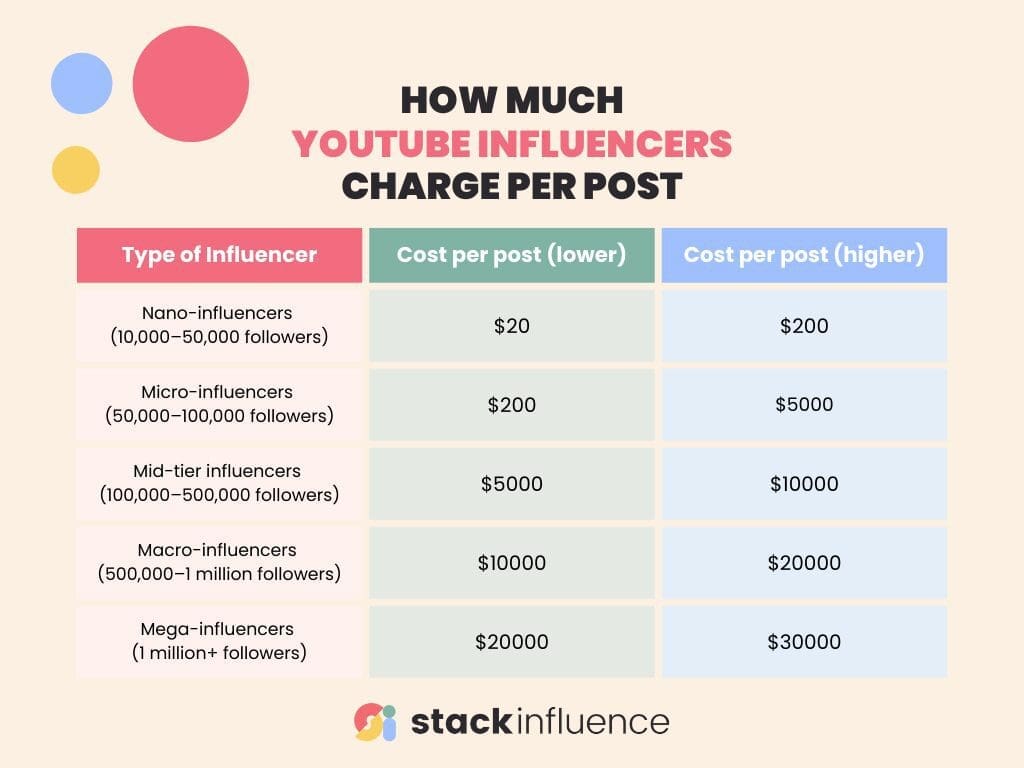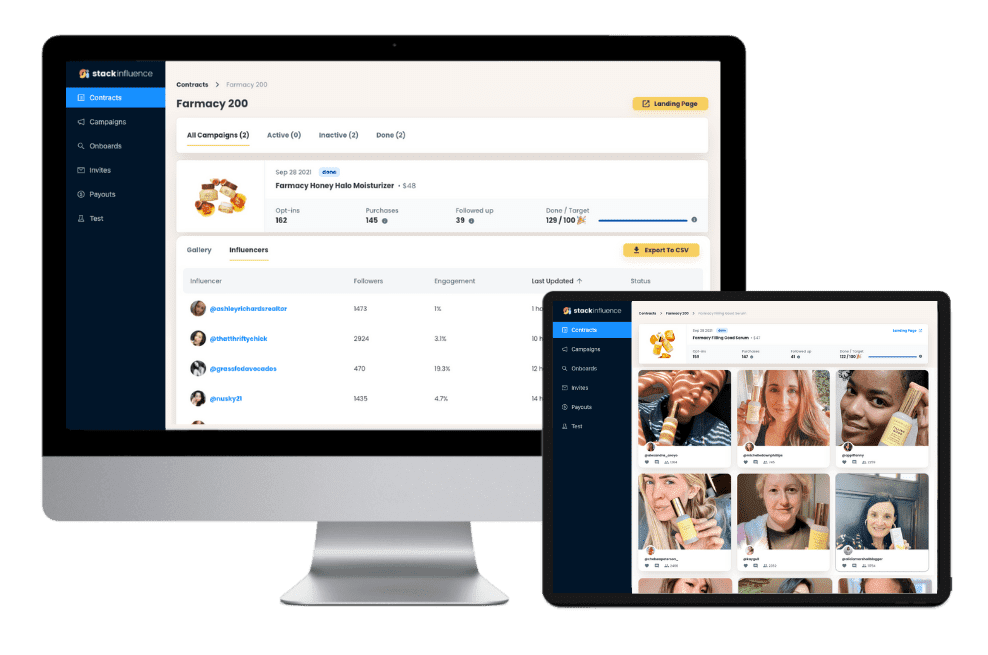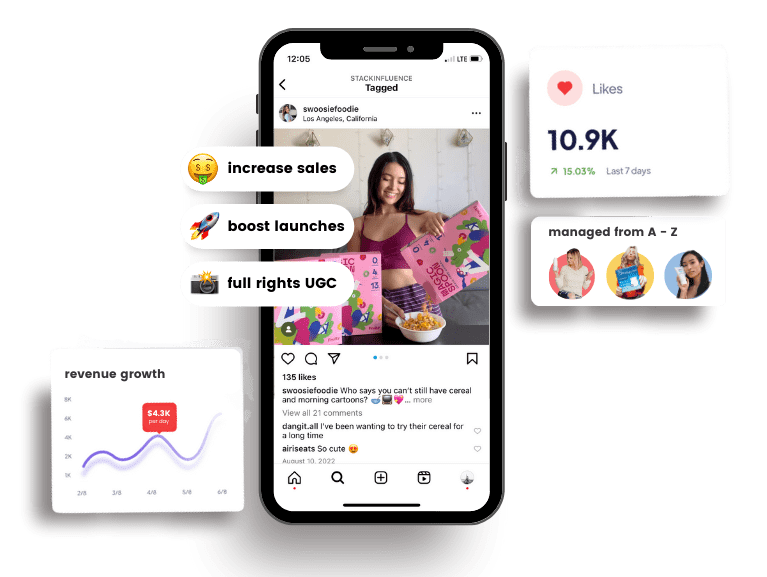How Much Do Influencers Cost?
27th
Amazon Influencers
Influencer Marketing
Amazon Marketplace
Influencer marketing has become an indispensable tool for businesses striving to connect with their target audience in a more authentic and relatable manner. From Instagram to YouTube and TikTok, influencers wield significant power to sway consumer behaviors and shape brand perceptions.
However, one of the most pressing concerns for brands looking to dive into the realm of influencer marketing is understanding the associated costs.
Businesses need to gain a comprehensive understanding of influencer marketing cost dynamics and pricing strategies to make informed decisions about their marketing budgets and potential return on investment.
This article delves into the intricacies of influencer marketing cost, drawing insights from reputable sources like Shopify, to offer a nuanced perspective on how brands can navigate and leverage influencer marketing effectively.
Understanding Influencer Marketing Cost
When it comes to influencer marketing, one of the biggest challenges businesses face is understanding the costs associated with collaborating with influencers.
While it may seem like a simple matter of paying influencers to promote products or services, the reality is much more nuanced. Influencer marketing cost depends on various factors, including the platform, type of content, reach, and engagement.
Influencers have invested significant time and effort into growing their audiences and building trust, which is why they charge for collaborations. According to Bussiness Insider, influencers consider ad revenue to be their primary source of income.
Influencers are professionals in their respective fields, and compensating them fairly for their work is crucial for maintaining a mutually beneficial relationship.
The platform on which influencers operate plays a significant role in determining their rates. Instagram, TikTok, and YouTube are popular platforms for influencer marketing, each with its own cost structure.
For instance, Instagram influencer pricing can vary widely based on factors such as follower count, engagement rate, and type of content (feed posts, Stories, Reels, etc.). According to Shopify influencers with 100,000 to 500,000 followers on Instagram can charge an average of $5,000 to $10,000 per sponsored post.
TikTok, the short-form video sensation, has become an influential platform for brands aiming to reach younger audiences. According to Shopify TikTok influencer pricing tends to be lower compared to other platforms, with influencers with 10,000 to 100,000 followers charging an average of $100 to $2,000 per sponsored post.
YouTube, with its strong focus on long-form video content, allows influencers to build deep connections with their subscribers. The cost of collaborating with YouTube influencers varies based on their subscriber count and the average views their videos receive. According to Shopify YouTube influencers with 100,000 to 1 million subscribers tend to charge between $10,000 to $20,000 per sponsored video.
It’s worth noting that these are average rates, and depending on various factors such as niche, expertise, and engagement rates, influencer pricing can vary significantly. It’s essential for businesses to carefully evaluate their target audience and campaign objectives to identify influencers whose rates are aligned with their marketing budget.
Additionally, engaging micro-influencers, who typically have smaller followings but highly engaged audiences, can be a cost-effective alternative. These influencers often charge lower rates while offering high-quality content and strong connections with their followers.
Understanding the intricacies of influencer marketing cost is crucial for designing effective campaigns that yield a positive return on investment. By considering factors such as platform, content type, reach, engagement, and the benefits of long-term partnerships, businesses can navigate the complex landscape of influencer marketing and harness its potential for growth.
Instagram Influencer Pricing

- Nano-influencers (100–10,000 followers): $10 to $100 per post
- Micro-influencers (10,000–50,000 followers): $100 to $500 per post
- Mid-tier influencers (50,000–100,000 followers): $500 to $5,000 per post
- Macro-influencers (100,000–500,000 followers): $5,000 to $10,000 per post
- Mega-influencers (500,000+ followers): $10,000+ per post
Instagram has emerged as a powerhouse for influencer marketing, with its visually-driven interface and a user base of over one billion active monthly users. Given its vast reach and diverse user demographics, brands are keen to harness the platform’s potential through influencer collaborations. However, when it comes to determining Instagram influencer pricing, several factors come into play.
Influencer pricing on Instagram varies widely based on metrics such as follower count, engagement rate, type of content (feed posts, Stories, Reels, etc.), and the influencer’s niche or expertise.
Follower count alone does not always reflect an influencer’s true reach and effectiveness. Beyond sheer numbers, engagement rate—measured by likes, comments, and shares—serves as a crucial gauge of an influencer’s ability to resonate with their audience.
Micro-influencers, who typically have smaller but highly engaged followings, offer a cost-effective alternative for brands seeking authentic connections with their target market. These influencers often charge lower rates while delivering high-quality content and fostering strong rapport with their followers.
Additionally, the type of content an influencer creates impacts their pricing. For instance, Instagram Stories and Reels have gained prominence as effective storytelling formats, and influencers adept at producing engaging, impactful content in these formats may command higher rates. When collaborating with influencers, brands should consider the creative versatility and compatibility of an influencer’s content style with their marketing objectives.
It’s also crucial for brands to recognize the potential longevity of influencer partnerships. While one-off campaigns may serve specific, short-term goals, establishing enduring relationships with influencers can lead to greater authenticity, trust, and improved campaign performance.
Although long-term collaborations might necessitate a higher investment, their ability to foster sustained brand-consumer connections makes them a compelling option for brands aiming for enduring impact.
Navigating Instagram influencer pricing demands a comprehensive understanding of various factors such as follower count, engagement rate, content type, and the benefits of long-term partnerships. By carefully considering these elements, brands can make informed decisions about their influencer marketing strategies and ensure a positive return on investment.
TikTok Influencer Pricing

- Nano-influencers (100 –10,000 followers): $5 to $25 per post
- Micro-influencers (10,000–100,000 followers): $25 to $125 per post
- Mid-tier influencers (100,000–500,000 followers): $125 to $1,200 per post
- Macro-influencers (500,000–1 million followers): $1,200 to $2,500 per post
- Mega-influencers (1 million+ followers): $2,500+ per post
TikTok, the short-form video platform that has taken the social media world by storm, presents a unique landscape for influencer marketing. With its emphasis on creative video content and its rapidly growing user base, TikTok has become a favored platform for brands aiming to reach younger audiences through influencer collaborations. When it comes to understanding TikTok influencer pricing, several factors come into play.
Engagement plays a critical role in determining the effectiveness and value of TikTok influencer partnerships. TikTok’s algorithm prioritizes content that generates high levels of engagement, including likes, comments, and shares, making it essential for brands to collaborate with influencers who can foster meaningful interactions with their audience. Micro-influencers on TikTok, with their dedicated and engaged followings, often offer a cost-effective means for brands to amplify their message in an authentic and impactful manner.
The type of content an influencer creates on TikTok also influences their pricing. With TikTok’s focus on short, engaging videos, influencers who demonstrate creativity, authenticity, and the ability to capture viewers’ attention quickly are in high demand. Brands seeking to leverage TikTok influencer partnerships should assess an influencer’s content style, storytelling capabilities, and alignment with their brand values to ensure a successful collaboration.
Long-term partnerships with TikTok influencers can further enhance a brand’s marketing strategy. While short-term campaigns may achieve immediate goals, sustained collaborations foster trust, loyalty, and deeper connections with audiences. Brands willing to invest in long-term relationships can benefit from increased brand affinity, consistent messaging, and a more significant impact on consumer behavior over time.
TikTok influencer pricing is influenced by a multitude of factors, including follower count, engagement rate, content type, and the potential advantages of long-term partnerships. By considering these elements and aligning them with their marketing objectives, brands can navigate the dynamic world of TikTok influencer marketing and tap into its immense potential for audience engagement and brand growth.
YouTube Influencer Pricing

- Nano-influencers (100 – 10,000 followers): $20 to $200
- Micro-influencers (10,000–100,000 followers): $200 to $5,000
- Mid-tier influencers (100,000–500,000 followers): $5,000 to $10,000
- Macro-influencers (500,000–1 million followers): $10,000 to $20,000
- Mega-influencers (1,000,000+ followers): $20,000+
YouTube, the world’s largest video-sharing platform, has become a powerhouse for influencer marketing. With billions of monthly active users and a diverse range of content creators, YouTube offers brands an opportunity to reach vast audiences through engaging video content. However, determining YouTube influencer pricing can be a complex endeavor, influenced by several key factors.
Engagement is a crucial aspect to consider when evaluating the effectiveness of YouTube influencer partnerships. Beyond subscriber count, assessing metrics such as average views, likes, comments, and shares provides insights into an influencer’s ability to connect with their audience. Higher engagement rates indicate a dedicated and involved community, increasing the likelihood of brand messaging resonating with viewers in a meaningful way.
Another determining factor for YouTube influencer pricing is the type of content created. Content formats on YouTube can vary widely, including vlogs, tutorials, reviews, and entertainment videos. Influencers who specialize in creating high-quality, well-produced content often command higher rates due to their expertise and ability to captivate and retain viewers’ attention. Brands should consider the alignment between an influencer’s content style and their marketing goals to ensure a successful collaboration.
Additionally, the duration of YouTube influencer partnerships can impact pricing. Short-term campaigns may serve specific objectives, but brands that seek to foster long-lasting connections with their target market often benefit from sustained collaborations. Long-term partnerships enable influencers to become brand advocates, delivering consistent messaging and deeper audience engagement.
It is important to note that YouTube influencer pricing can vary significantly based on the influencer’s location and market. Influencers based in specific geographic regions, such as North America or Europe, typically command higher rates compared to those in emerging markets. Brands should consider factors such as regional demographics, the cost of living, and the influencer’s global reach when evaluating pricing structures.
In conclusion, YouTube influencer pricing is influenced by various factors, including subscriber count, engagement rate, content type, partnership duration, and market dynamics. By carefully analyzing these elements, brands can make informed decisions about their YouTube influencer marketing strategies, ensuring a positive return on investment and the ability to harness the vast reach and influence of YouTube’s creator community.

Unlock the Power of Micro Influencers and Elevate your Brand Today!

How to Find the Right Influencer for Your Budget

Before diving into the search for an influencer, it’s crucial to establish clear marketing objectives and allocate a realistic budget.
Identify who your target audience is and what demographics, interests, and behaviors they exhibit.
Once you have defined your goals and identified your target audience, it’s time to conduct research to find influencers who match your criteria.
Micro-influencers, who typically have a smaller following of 10,000 to 100,000, can offer a cost-effective option for brands with limited budgets. While their reach may be smaller, micro-influencers often boast higher engagement rates due to their close-knit communities.
These provide detailed insights, audience demographics, engagement metrics, and previous brand collaborations.
Influencer Marketing Platforms
Influencer marketing platforms play a crucial role in connecting brands with a vast network of content creators, amplifying brand awareness, and fostering authentic engagement. These platforms offer diverse benefits, catering to the needs of both brands and creators.
Stack Influence: Connecting Brands to Everyday Creators
Platform Benefits
Stack Influence is a leading micro-influencer marketing platform that facilitates automated product seeding campaigns, promoting brand awareness, user-generated content, and online growth. By leveraging the Stack Influence platform, brands gain access to a diverse community of micro-influencers across various niches such as fitness, beauty, fashion, and technology. These influencers are extensively vetted, ensuring targeted and authentic brand partnerships.
Pricing and Compensation
One unique feature of Stack Influence is its compensation model. Micro-influencers on the platform are compensated with products, leading to social posts that reflect genuine consumer experiences. This approach fosters word-of-mouth marketing at scale and results in more organic conversations about the promoted products.
Managed Campaigns and Content Creation
Stack Influence offers fully managed campaigns, delivering branded content, accumulating testimonials, and boosting brand awareness and traffic. The platform utilizes AI to hyper-target micro-influencers, coordinating campaign requirements and managing the creative timeline. This hands-on approach ensures that social posts align with brand messaging and goals without inventory loss for the brands
Influencer Community
Stack Influence boasts a community of over 11 million micro-influencers, meticulously organized and vetted based on demographics, psychographics, and geographic locations. This extensive network provides brands with a wide array of influencer options, spanning various niches and ensuring targeted collaborations.
Overall, Stack Influence stands out as a comprehensive micro-influencer marketing solution, offering managed campaigns, access to a diverse influencer network, and a unique product compensation model.
Conclusion
Influencer marketing continues to thrive as a powerful strategy for brand promotion and consumer engagement in today’s digital landscape.
With a projected market value of $22.2 billion in 2025 according to Statista influencer marketing has solidified its position as a significant driver of brand visibility, trust, and sales conversions.
This makes it more important than ever to prioritize your business’ influencer marketing strategy! We hope this has helped you grasp an idea of how influencers get paid for their digital advertisements.
Influencer marketing has become a powerful tool for brands to connect with their target audiences. However, finding the right influencer who aligns with your brand values, audience demographics, and budget can be a challenging task. Here are some key steps to help you identify the perfect influencer partnership within your budget.
Want new articles before they get published?
Subscribe to our Awesome Newsletter.
Want new articles before they get published? Subscribe to our Awesome Newsletter.
stack up your influence
turning creativity into currency
our headquarters
111 NE 1st St, Miami, FL 33132
our contact info
[email protected]
stack up your influence
turning creativity into currency
our headquarters
111 NE 1st St, 8th Floor
Miami, FL 33132


